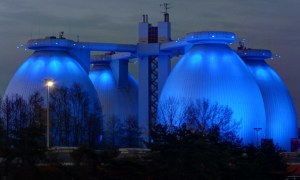🕑 Reading time: 1 minute
Sewer sanitary system consists of network of pipelines to carry wastewater from houses to wastewater treatment system. Setting up layout for sewer sanitary system with procedure is discussed.
Fig.1: Sewer Sanitary System Layout

Requirements for Sewer Sanitary System Layout Setup
Following are the several parameters or requirements that should be specified by the design before setting up layout for sewer sanitary system:- Specify an outlet for sewer sanitary system which is based on the conditions of the project. So, the system might discharge into pumping station, treatment plant, or trunk or main sanitary sewer.
- Estimating tributary area.
- Positioning main sewers and trunk.
- Decide whether pumping station is required or not.
- Specify the location of the pump station, if needed.
Setting Up Sanitary Sewer System Layout
The initial layout of sewer sanitary system is set up based on the topography of the area and related information. The slope of the sewer system is dependent on the gradient of the area as shown in Figure-2. The slope of the sewer system is joined by trunk or main sewers but the exact location is influenced by number of factor such as position of utilities, type and extent of pavement that might be encountered, availability of right of way and traffic conditions.
Fig.2: Sewer Sanitary Gradient in the Same Direction as Ground Surface or Street
Sewer system drainage district border is governed by separated area, water drainage basin, ridgelines or high points. Sub-district boundaries located in a district is controlled by topography, economy of sewer sanitary layout or any other practical factor that needs considered. It should be known that, the need for main, trunk and intercepting sewer sanitary system is not only dependent on the topographical limitations but also construction restrictions. Main, trunk and intercepting sewer sanitary system should be positioned at a lower elevation in a specific area as shown in Figure-3.
Fig.3: Sanitary Sewer Main Location
Sanitary sewer system should be designed in such a way that it takes the future requirements into consideration unless economic restriction prevents the execution of such considerations. Regarding the location of sewer sanitary system in relation of public water supplies, almost all codes and state standard specified certain distance between sanitary sewer mains and water mains both horizontally and vertically. For example, face to face horizontal distance between water mains and sewer mains should be minimum 3m and vertical distance should be less than 0.45m, and water mains should be located above sewer mains. If sewer mains are close to public water supplies, then it is required to take measures into account regarding sewer mains, such as, pressure type sewer pipe should be employed and concrete encasement of sewer pipe should be considered. As far as the location of manholes are concerned, they are commonly positioned at sewer sanitary junctions, at any variations in grade, size of the sewer pipe as shown in Figure-4, alignments apart from curved alignment and at locations which are provided to offer access to sanitary sewer system for maintenance and emergency purposes as can be observed in Figure-5.
Fig.4: Provision of Manholes for Sewer Sanitary System due to Changes in Pipe Sizes

Fig.5: Provision of Manhole for Maintenance, Inspection and Emergency Purposes
There are recommendations regarding manhole intervals which can be considered for the determination of manhole positions while sewer sanitary system is established. These recommendation is based on the diameter of the sewer pipe. For instance, 120m and 150m spacing can be adopted for sewer pipe diameter of 37.5cm and 75cm respectively and larger spacing can be employed for greater pipe diameter. This trend of adopting greater spacing cannot be used based on sewer size only because the ability of available cleaning equipment should also be considered and cleaning crew should be consulted in this regard. Another consideration about manhole placement determination is the prevention of manhole installation at low positions otherwise excessive inflow would occur due to water flow concentration over the top of the manhole. This measure might lead to construction of large number of manholes. If manholes are constructed at low locations, then it should be waterproofed and prevented against floatation. Manholes which are not needed in the future should be placed at street right of way instead of street intersection pavement to decrease problems while possible pavement rehabilitation is conducted in the future. The location of terminal manhole at the upper of sewer sanitary system should be within street right of way to ease accessibility of manhole and sewer for emergency and maintenance reasons. However, such manholes may be placed at street intersection pavements if necessary measures are taken to ease manhole accessibility. When the location of manhole is such that surface water penetration is permitted, then either the location of the manhole should be changed or waterproofed manhole cover must be utilized. Read More: Quality, Handling and Installation of Sewer Sanitary Pipes Design and Construction of Flexible Sewer Sanitary Pipes Special Construction of Sewer Sanitary Pipe System -Methods and Considerations Drains and Sewers Terms Definitions Direct Design of Concrete Pipes for Sewer Sanitary Marston-Spangler Load Analysis Theory for Sewer Sanitary System


